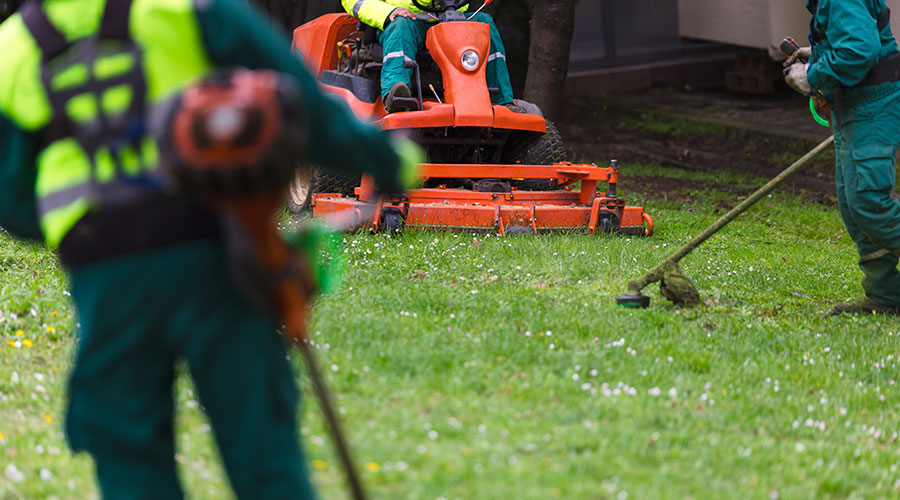How to Handle a Workplace Accident
Falls, electrocution and chemical exposure are common facility-related accidents. Follow these steps when the worst happens.
By Ashley Haley, Contributing Writer
In the facilities management industry, workplace accidents, such as falls, chemical exposure, overexertion and electrocution, are all too common.
Employee safety is a top priority for employers, and safety measures are required by the Occupational Safety and Health Administration (OSHA), which is why many employers have a plan in place, if or when, an accident occurs.
Julie Sobelman, a senior environmental health and safety (EHS) consultant, says there are four broad issues when a workplace accident occurs.
First, the immediate needs of the injured, their families and potentially traumatized coworkers must be dealt with. Medical attention should be provided if needed.
“Companies should have some type of emergency plan in place so they at least have a ‘roadmap’ for accidents,” Sobelman says.
Second, the accident scene must be stabilized, but not altered, to make sure it is safe to investigate. Next, the incident should be investigated, as soon as possible, before the scene is altered.
“Investigation can be done by the company, their insurance provider, outside specialist or a combination,” Sobelman says. “The National Safety Council offers courses in incident investigation, which should be part of every manager’s ‘toolbox.’ The link to OSHA’s website on incident investigation also has some useful information. The investigation should determine root causes and identify potential corrective actions for the company to prevent reoccurrence.”
OSHA’s website states that incident investigations should focus on identifying and correcting root causes and not on finding fault or blame, as this improves workplace morale and increases productivity by showing an employer’s commitment to safety and health. The website also states that, although investigations are often conducted by a supervisor, they should include managers and employees as they bring different perspectives and knowledge.
“In conducting an incident investigation, the team must look beyond the immediate causes of an incident,” the website states. “It is far too easy, and often misleading, to conclude that carelessness or failure to follow a procedure alone was the cause of an incident. To do so fails to discover the underlying or root causes of the incident, and therefore fails to identify the systemic changes and measures needed to prevent further incidents.”
During the investigation, the OSHA website states it’s important to ask questions that address shortcomings, including why rules and procedures weren’t followed if it’s been found that they weren’t, whether production pressures played a role, and whether procedures or safety training were out of date. These questions help discover the factors leading to the incident, which usually involves issues with equipment, procedures and training, according to the OSHA website.
Lastly, regarding an OSHA investigation, Sobelman points to company policy and being prepared. Some questions to consider prior to an accident include whether the company has a safety professional who can be onsite to assist, or if the company wants legal representation, onsite, during an investigation.
“If the facility manager is on his own to deal with OSHA, honesty is the best policy. If possible, have them put all of their requests for information in writing and provide a response in writing,” she says. “Do not withhold information, but do not offer information that wasn’t specifically requested – again consult with company legal counsel for guidance.”
Onsite fatalities
After a workplace accident occurs and medical attention is provided, first, ensure that the environment does not pose any immediate danger. Take short-term precautions to protect other people in the area. For example, if there was a crack in the floor that caused an accident, cover it up.
If a fatality occurred, cordon off the area and make sure no one touches or moves anything – treat the area like a crime scene, says Rusti Dyals, national director of EHS at Elevating Solutions in Facilities Management (ESFM). Facility managers especially will be highly involved in assisting here. This may include shutting down production in that area or even the entire facility.
"Depending on the type or severity of the injury will determine whether OSHA must be notified and how soon," says Dyals.
For example, within 8 hours of a fatality or within 24 hours for in-patient hospitalization of one or more employees, amputation, loss of eye. This is done through a phone call.
Basic information must be provided to OSHA, including a company name, location and time of the incident, type of incident, employee names, contact information, and a brief description of the incident, says Dyals.
“Some states have a state-run OSHA that must be notified instead of federal OSHA,” adds Dyals. “OSHA will determine if a visit is warranted based on the information provided, but they do usually follow up with at least a phone call or email.”
An internal investigation should be initiated, regardless of whether or not OSHA schedules a follow-up visit to determine the root causes of the incident, Dyals says. Whatever is needed to document the events as accurately as possible, including pictures, witness statements and measurements, should be gathered.
“Gather as much information as you can to ensure you are making educated assumptions (when necessary) to determine long-term solutions to prevent reoccurrence of the incident,” Dyals says. “It’s all about ensuring a safe environment and protecting the employees. That’s what’s important.”
Facility managers often will not conduct all these tasks alone. The company’s EHS professional will support and manage conversations with OSHA. The facility manager’s role is to help secure the area of the incident and assist with walkthroughs.
After an investigation has taken place, whether privately or through OSHA, and the cause of the incident has been identified, the company should implement new plans or procedures to avoid future incidents. This may include updated safety training, new equipment with safety mechanisms, or different protocols. Not only will this show the company's commitment to health and safety to employees, but it can prevent the same incident from happening twice.
Ashley Haley is a freelance writer with Advantage Informatics.
Related Topics:












